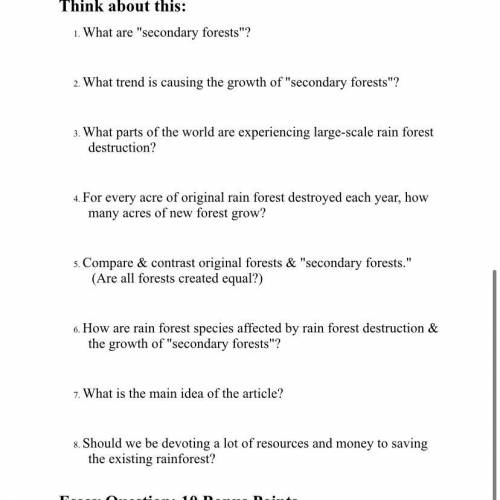
EXTREMELY EASY
Read the article then answer the questions on the picture
Are All Forests Created Equal?
As abandoned farmland in the tropics reverts to nature, scientists debate whether saving primeval rain forest is as urgent as once thought
By Elisabeth Rosenthal in Panama
The land in Chilibre, Panama, where Marta Ortega de Wing once raised hundreds of pigs, is now being overtaken by galloping jungle filled with palm trees, lizards, and ants. Instead of farming, she now shops at the supermarket and her grown children and grandchildren live in places like Panama City and New York. "There is far more forest here than there was 30 years ago," says Ortega de Wing, who remembers fields of mango trees and banana plants.
Around the globe, farmland is reverting to nature as jobs and opportunities for a better life lure people to fast-growing cities, and advances in agricultural technology mean that fewer farmers are needed to feed the world's growing population.
As a result, "secondary" forests are emerging in Latin America, Asia, and other tropical regions at such a fast pace that there's now a serious debate about whether saving primeval, or original, rain forest—a longtime environmental cause—may be less urgent than once thought. By one estimate, for every acre of rain forest cut down each year, more than 50 acres of new forest are growing in the tropics on land that was once farmed, logged, or ravaged by natural disaster.
Some scientists say the new forests could blunt the effects of rain-forest destruction by absorbing carbon dioxide—the leading heat-trapping gas linked to global warming—one crucial role that rain forests play. They could also, to a lesser extent, provide habitat for endangered species.
"Biologists were ignoring these huge population trends and acting as if only original forest has conservation value, and that's just wrong," says Joe Wright, a scientist for the Smithsonian Institution in Washington, D. C., who thinks that new forests could substantially compensate for rain-forest destruction. Wright is also concerned that overzealous concern with rain forests robs attention—and money—from other ways to fight global warming, like eliminating coal-burning power plants.
Others disagree. "Yes, there are forests growing back, but not all forests are equal," says Bill Laurance, another Smithsonian scientist, who has worked extensively in the Amazon, where the original rain forest makes up a complete ecosystem. He calls Ortega de Wing's overgrown land a caricature of a rain forest: "There's no canopy, there's too much light, there are only a few species."
Everyone, including Wright, agrees that large-scale rainforest destruction in the Amazon, Borneo, and other tropical areas should be limited. What's difficult is determining how old forests compare with new ones in their environmental value.
Impact on Plants & Animals
About 38 million acres of original rain forest are being cut down every year. But in 2005, according to the United Nations, there were 2.1 billion acres of potential replacement forest growing in the tropics—an area almost as large as the United States.
With the heat and rainfall in tropical places like Panama, new growth is remarkably fast. Within 15 years, abandoned land can contain trees more than 100 feet high. Within 20, a thick rain-forest canopy forms again.
But Laurance is concerned about the scale of original rain-forest destruction, "where every stick of timber is being cut in Congo and sent to China and one bulldozer does a lot more damage than 1,000 farmers with machetes," he says.
Many biologists question whether new forests can support the biodiversity of plant and animal species associated with rain forests. Part of the problem is that new growth is often far from the original rain forests where species are endangered: How does it help species threatened by the destruction of the Amazon in Brazil if secondary forests are growing in Panama?
Wright says new research suggests that 40 to 90 percent of rain-forest species can survive in new forest. But Laurance focuses on what will be missing—species like jaguars, tapirs, and a variety of birds and invertebrates. While he concedes that a regrown forest may absorb some carbon dioxide, he insists, "This is not the rich ecosystem of a rain forest."


Answers: 2
Another question on English

English, 21.06.2019 19:00
Choose the letter of the word that most clearly expresses the tone in each passage. if you are unfamiliar with any of the words, look them up before you select the correct answer. we have come together this afternoon to mourn the deaths of sixteen miners—our friends and neighbors—who were trapped by fire yesterday, deep below the earth. they lived bravely and they died too soon, leaving behind grieving wives and bewildered children. we bid them a final farewell. question 1 options: forgiving sorrowful angry amused
Answers: 1

English, 22.06.2019 01:10
Ato of . it be a , is as an . it be a ,in - as a . , it be an , is by to as a , , or an .. (s)of : 12345
Answers: 2

English, 22.06.2019 03:00
What lines in this expert from act v of shakespeare’s romeo and juliet create dramatic irony
Answers: 1

English, 22.06.2019 03:00
In the odyssey - amphimedon, what motivates odysseus to dress like a beggar? a.)he is trying to be humble. b.)he wants to surprise penelope. c.)he is angry at amphimedon. d.)he wants revenge against the suitors.
Answers: 1
You know the right answer?
EXTREMELY EASY
Read the article then answer the questions on the picture
Are All Fores...
Are All Fores...
Questions

Mathematics, 23.02.2021 08:50



History, 23.02.2021 08:50

English, 23.02.2021 08:50

English, 23.02.2021 08:50

Mathematics, 23.02.2021 08:50


Mathematics, 23.02.2021 08:50


Biology, 23.02.2021 08:50

Mathematics, 23.02.2021 08:50





Mathematics, 23.02.2021 08:50

Health, 23.02.2021 08:50

English, 23.02.2021 08:50




